Questa guida completa suddivide l'intero processo di personalizzazione, dalla selezione dei materiali ai flussi di lavoro di fabbrica. Sia che tu stia lanciando una nuova linea di prodotti o perfezionando la tua strategia di approvvigionamento, Questo articolo ti doto di conoscenza della produzione critica.
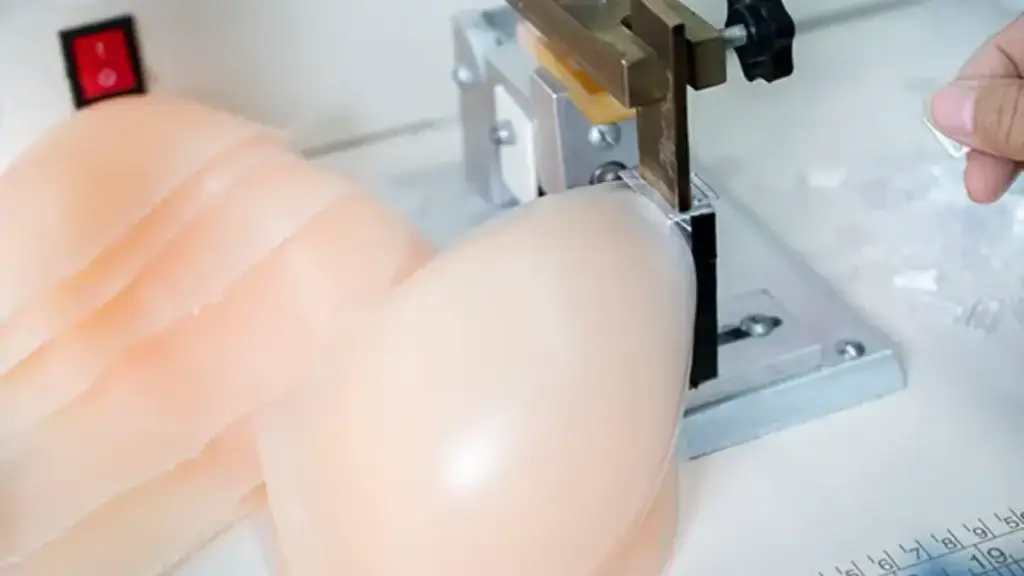
Panoramica dei tipi di reggiseno in silicone e personalizzazione Possibilità
Prima di immergersi su come personalizzare il reggiseno al silicone in una fabbrica, È importante comprendere le categorie di prodotti disponibili per la personalizzazione.
La tabella seguente riassume i tipi più comuni di reggiseni di silicone fabbricati su scala:
| Tipo | Caratteristiche principali | Vantaggi | Target utenti |
| Reggiseno adesivo classico | Due tazze adesive, Nessun cinturino | Invisibile sotto l'abbigliamento, riutilizzabile | Utenti generali, usura della moda |
| Push-up di chiusura frontale | Chiusura tra le tazze, Sollevaggio di scollatura forte | Schedaggio migliorato, Fit sicuro | Giovani consumatori, abbigliamento da festa |
| Reggiseno adesivo alato | Flap laterali estesi per un ulteriore supporto | Migliore adesione e copertura | Taglie più grandi del busto |
| Reggiseno di sollevamento | Schede adesive per sollevamento verticale | Sollevamento naturale, design minimalista | Utenti petite, usura formale |
| Copricapezzoli in silicone | Leggero, coperture rotonde | Ultra-Discreet, facile da usare | Utenti minimalisti, abbigliamento quotidiano |
Ogni tipo offre livelli di supporto diversi, estetica, e potenziale di personalizzazione, come il grado adesivo, corrispondenza del colore, Impronta del logo, e opzioni di imballaggio.
Materiali chiave utilizzati nella produzione di reggiseno in silicone
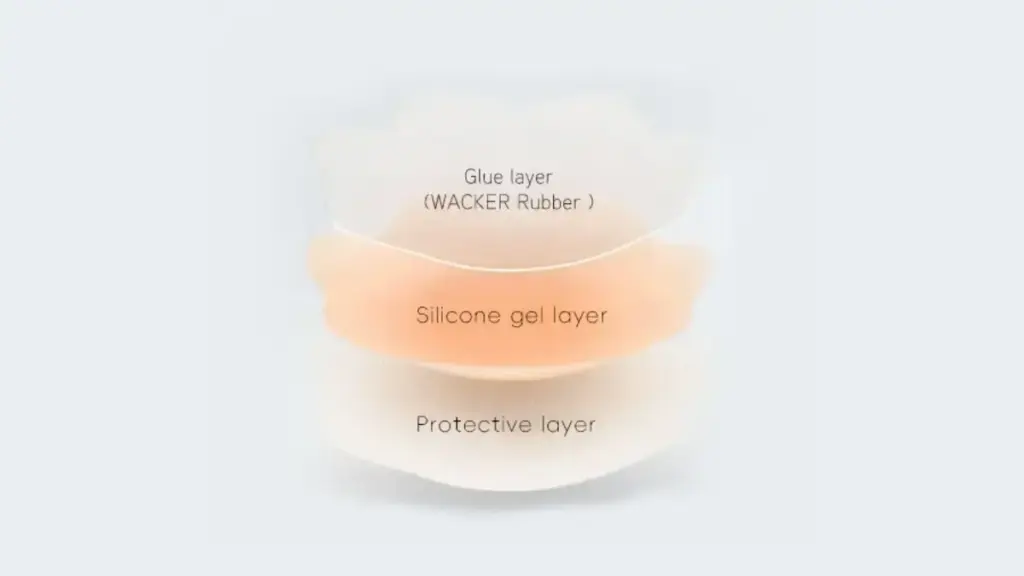
La selezione del materiale influisce in modo significativo sulla qualità, comfort, e durata dei reggiseni di silicone. Ciò è particolarmente importante per i prodotti progettati per il contatto prolungato della pelle.
- Gel di silicone: Il materiale di riempimento principale, Disponibile in diverse densità. I tipi di platino soddisfano gli standard FDA e LFGB per la sicurezza della pelle.
- TPU Film (Poliuretano termoplastico): Usato come strato esterno per contenere il gel, noto per flessibilità e durata.
- Adesivi di livello medico: Garantire un'adesione sicura alla pelle senza irritazione. I tipi variano in base al caso d'uso: mono-uso vs riutilizzabile.
- Film protettivi per animali domestici: Post-produzione applicata per proteggere le superfici adesive prima dell'uso del consumatore.
Per coloro che indagano su come personalizzare il reggiseno al silicone in una fabbrica, Selezionare la configurazione del materiale giusto allineato con le aspettative dell'utente finale e le normative sul mercato è un primo passo fondamentale.
Processo passo-passo per personalizzare il reggiseno in silicone in una fabbrica
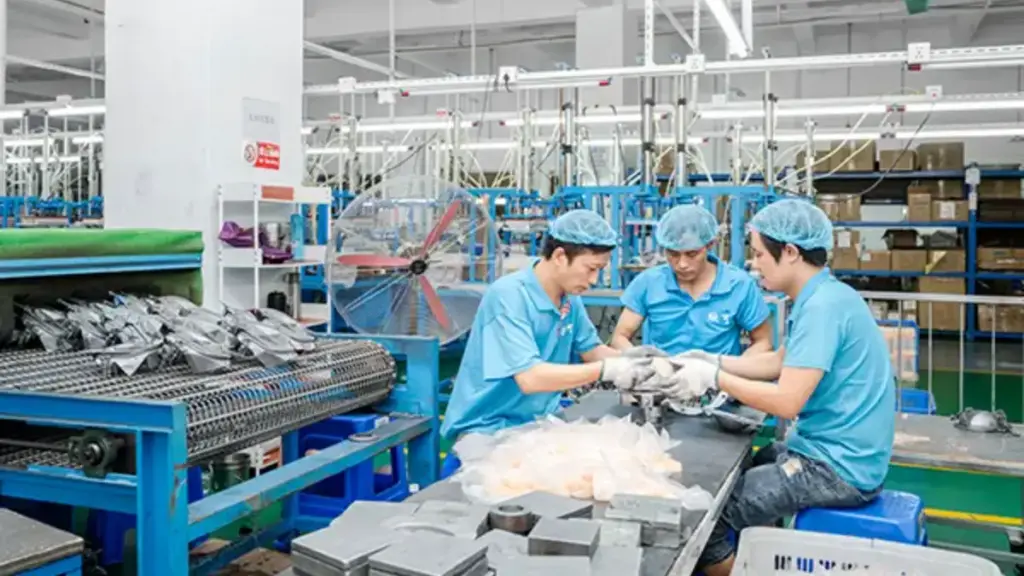
A xksilicone, Il processo di produzione del reggiseno in silicone segue un flusso di lavoro preciso e controllato dalla qualità, Combinando la competenza materiale, Precisione ingegneristica, e decenni di esperienza nel settore. Di seguito è riportato una rottura approfondita di ogni passaggio coinvolto nella personalizzazione di reggiseni di silicone.
Preparazione delle materie prime
Il processo inizia con la selezione di gel di silicone in platino di alto grado, noto per la sua sicurezza della pelle, durabilità, e conformità con certificazioni internazionali come PORTATA, E SGS. Per garantire un aspetto naturale e una sensazione, Il gel è regolato per una morbidezza specifica (Shore una durezza) e abbinato a colori usando la miscelazione del pigmento. La simulazione accurata del tono della pelle è fondamentale, Soprattutto per i clienti che richiedono opzioni di colore personalizzate nei mercati globali.
Stampaggio a iniezione (Riempimento in gel)
Il gel di silicone viene iniettato in stampi preriscaldati che definiscono la forma e il volume di ogni reggiseno. I disegni di muffe sono personalizzati in base alle specifiche del cliente, che si svolgono da una a tazze E - e consentono variazioni di spessore da 8 mm a 20 mm a seconda dei requisiti di sollevamento o copertura. La temperatura e la pressione dello stampo sono strettamente regolate per mantenere la densità uniforme e prevenire la formazione di bolle.
Laminazione del film in tessuto e PU
Una volta modellato, Ogni tazza è coperta da un poliuretano di livello medico (Pu) film, Spesso combinato con tessuto soft-touch. Il film funge da barriera sicura per la pelle e supporta anche l'adesione del gel sulla superficie esterna. La laminazione viene eseguita utilizzando strumenti di allineamento precisi per evitare rughe o stretching.
Rivestimento adesivo
Sulla superficie interna, Un adesivo sensibile alla pressione viene applicato in ambienti per mantenere la purezza e l'ipoallergenicità. Il rivestimento deve essere uniforme per garantire un'adesione costante in vari tipi di pelle e condizioni di umidità. Xksilicone utilizza una formula adesiva proprietaria ottimizzata per la resistenza e la riusabilità del sudore.
Sigillatura del bordo e lucidatura della superficie
I bordi sono sigillati utilizzando tecniche di legame termico per creare fluidi, contorni non irritanti. Ogni unità subisce lucidatura superficiale per migliorare la trasparenza ed eliminare le imperfezioni visive. Questi passaggi sono essenziali per garantire il comfort chi lo indossa e il fascino estetico.
Currerazione e modellatura finale
Le tazze del reggiseno sono collocate in un forno a temperatura controllata (Tipicamente 80–120 ° C.) per indurimento termico. Questo stabilizza l'adesivo e finalizza la forma strutturale. È possibile eseguire un taglio aggiuntivo per garantire la simmetria tra le coppie.
Ispezione e imballaggio
Ogni lotto è soggetto a controlli dimensionali, ispezione visiva, e test di forza di adesione. XKSilicone, aderisce a una metodologia di produzione 5S - Sort, Metti in ordine, Splendore, Standardizzare, Sostenere, per quanto riguarda ogni reggiseno in silicone soddisfa benchmark di controllo di qualità rigorosi. I prodotti sono quindi confezionati in base al marchio del cliente o ai requisiti di marchio del distributore.
Questo processo di produzione strutturato e tracciabile garantisce risultati coerenti, rafforzare l'impegno per l'affidabilità e la produzione di livello cosmetico.
OEM vs ODM e opzioni di personalizzazione
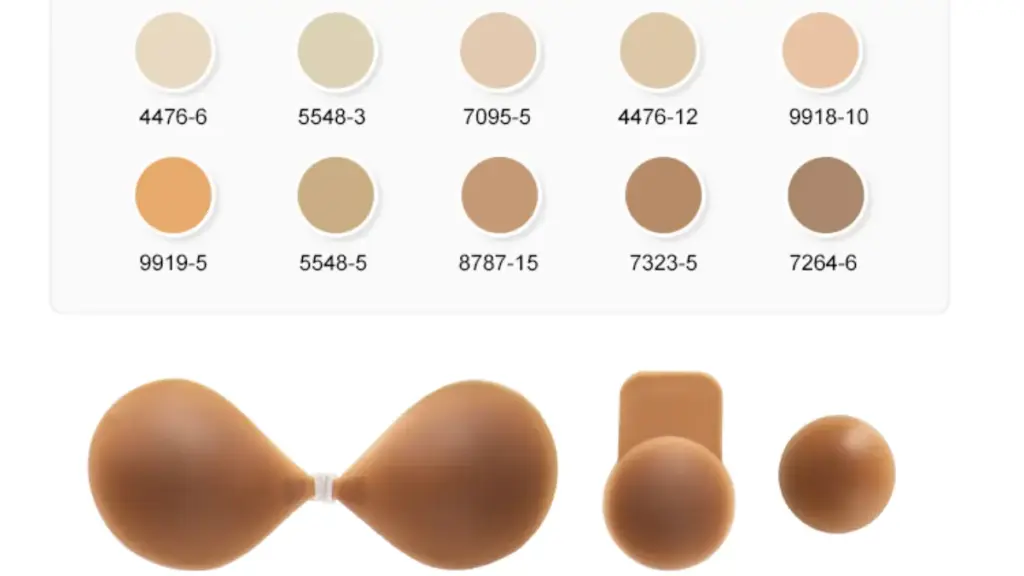
Nella produzione di reggiseno in silicone, Comprendere la differenza tra OEM (Produttore di apparecchiature originali) e ODM (Produttore di design originale) Aiuta i marchi a scegliere il giusto percorso di personalizzazione. OEM consente ai clienti di fornire requisiti di progettazione specifici e risorse del marchio, Ideale per i marchi di marchio del distributore. ODM offre modelli semifiniti per la personalizzazione della luce, Ridurre i tempi e i costi di lead di sviluppo.
Personalizzazione Le opzioni sono fondamentali per soddisfare le diverse esigenze di mercato. Ecco le aree chiave:
- Spessore di tazza: Le opzioni in genere vanno da 8 mm a 20 mm. Tazze più spesse (15–20 mm) offrire effetti push-up più forti e sono adatti per l'usura formale o serale, Mentre opzioni più sottili (8–12 mm) sono preferiti per la modellatura naturale e il comfort nell'usura quotidiana.
- Forma e contorno: La maggior parte delle fabbriche offrono round, lacrima, e forme alate, insieme a un contorno interno piatto o curvo. Gli stili alati aggiungono supporto per i busti più fulle, Mentre le forme di lacrima si adattano ai fotogrammi più piccoli in cerca di sollevamento.
- Tipo adesivo: Le opzioni includono gel di silicone di livello medico e acrilico sensibile alla pressione, su misura per il tipo di pelle, riusabilità, e clima regionale.
- Corrispondenza del colore: Le fabbriche spesso forniscono 4-6 toni nudi standard. Per un tono della pelle preciso corrispondente, Codice Pantone Viene utilizzato il campionamento di riferimento o in pelle.
- Logo e marchio: I client possono aggiungere loghi in rilievo, Etichette stampate, o anche codici QR per l'autenticità.
- Confezione: Scatole personalizzate con vassoi di inserimento, chiusure magnetiche, o l'eco-packaging sono disponibili per allinearsi con gli obiettivi di vendita al dettaglio.
Queste opzioni assicurano che il tuo marchio possa allineare le prestazioni del prodotto con le aspettative del mercato mantenendo la produzione scalabile e coerente.
Standard di controllo di qualità nella produzione di reggiseno in silicone
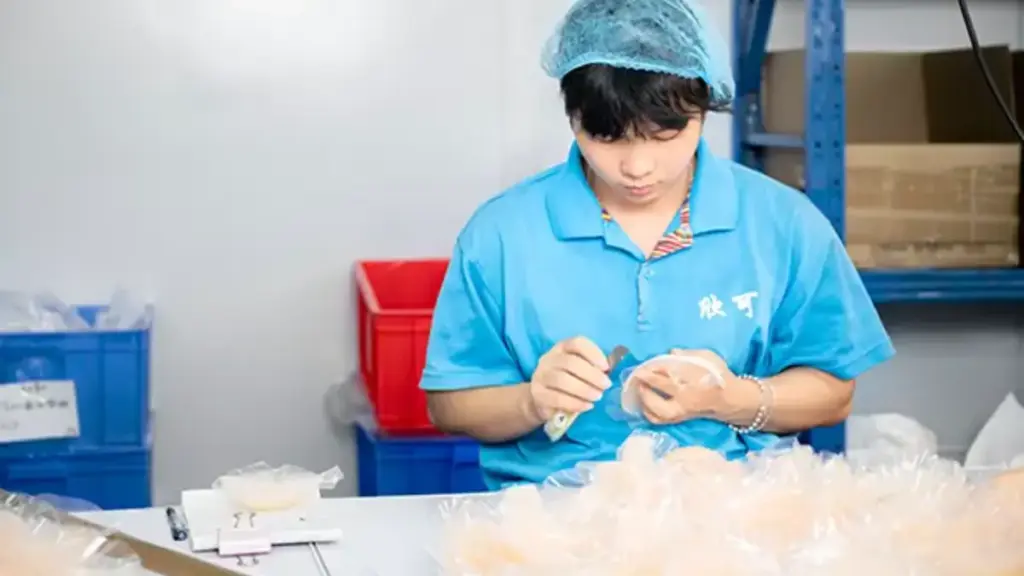
Test rigorosi aiutano ad affrontare le preoccupazioni comuni come “Il reggiseno al silicone è buono per la salute?” garantendo ipoallergenico, Materiali certificati per la pelle. Fabbriche che mirano a fornire coerenti, sicuro, e i prodotti ad alte prestazioni in genere si stabiliscono multistrato Sistemi QC in linea con gli standard di qualità internazionale.
- Ispezione del materiale in arrivo
Viscosità al silicone, Gel chiarezza, e la qualità adesiva viene testata.
Revisione della certificazione dei materiali (FDA, PORTATA).
- Ispezione in corso
Temperatura della muffa, tempo di cura, pressione di iniezione monitorata.
Campionamento casuale per la simmetria visiva, Controllo delle bolle d'aria.
- Ispezione finale del prodotto
Test di adesione: Forza di buccia sotto il carico.
Test di durabilità: Riutilizzare i cicli sotto calore e umidità.
Controllo dimensionale: Coerenza in forma e spessore.
Test di sensibilità della pelle (opzionale): Utilizzo della valutazione ipoallergenica.
- Documentazione batch
Campioni di conservazione, registri di produzione, e i rapporti di test sono archiviati per la tracciabilità.
La maggior parte delle strutture ad alto livello operano sotto ISO 9001 o iso 13485 per articoli in silicone legati al medico. L'adozione di questi sistemi non solo garantisce sicurezza, ma costruisce anche la fiducia dei clienti e la cooperazione a lungo termine, specialmente vitale quando esplorano come personalizzare il reggiseno al silicone in una fabbrica con clienti internazionali.
Come scegliere il giusto produttore del reggiseno in silicone

La selezione di un produttore di reggiseno in silicone affidabile richiede una valutazione a più angolo che va oltre il costo. Di seguito sono riportate due dimensioni chiave per guidare la tua decisione:
Tempi di consegna, Moq, e considerazioni sui costi
Efficienza della produzione, quantità di ordine minimo (Moq), e la trasparenza dei prezzi è fondamentale. Una fabbrica capace dovrebbe impegnarsi a condurre tempi di 15-30 giorni a seconda della complessità della personalizzazione, mentre offre MOQ scalabili a partire da 1,000 coppie. Chiari strutture di costo con utensili, campionamento, e le commissioni di imballaggio delineate in anticipo aiutano a evitare spese impreviste.
Standard di capacità tecnica e conformità
Valuta le capacità di ingegneria e controllo di qualità della fabbrica. I fattori chiave includono lo sviluppo di stampi interni, Capacità di personalizzare la forza adesiva in base al tipo di pelle, ed esperienza nella conformità internazionale. Le fabbriche di detenzione di certificazioni come SGS e REACH sono meglio attrezzate per servire i mercati regolamentati e garantire la sicurezza del prodotto.
Produttore di reggiseni di silicone consigliato
GZXKSilicone, un fornitore di reggiseno in silicone specializzato, Si distingue per la sua rigorosa applicazione della metodologia 5S (Ordinare, Metti in ordine, Splendore, Standardizzare, Sostenere) durante la produzione. I loro prodotti sono certificati con MSD, SGS, CA65, e RAGGIUNGERE, Soddisfare elevati standard di sicurezza internazionali. Con una profonda esperienza OEM/ODM, stampaggio di precisione, e competenza di abbinamento a colori, Xksilicone è un partner di fiducia per le etichette private globali in cerca di scalabile, soluzioni conformi.
Padroneggiare il processo di come personalizzare il reggiseno al silicone in una fabbrica richiede una profonda comprensione della scienza dei materiali, prestazioni adesive, Precisione della muffa, e conformità normativa. Questa guida ti ha guidato attraverso i passaggi chiave, Opzioni di personalizzazione, Modelli di produzione, e criteri di valutazione dei fornitori a supporto delle decisioni di approvvigionamento informato.
Per i marchi che cercano affidabili, scalabile, e completamente personalizzabile reggiseno in silicone soluzioni, La collaborazione con Xksilicone è una mossa strategica per garantire sia l'integrità del prodotto che il successo del mercato.